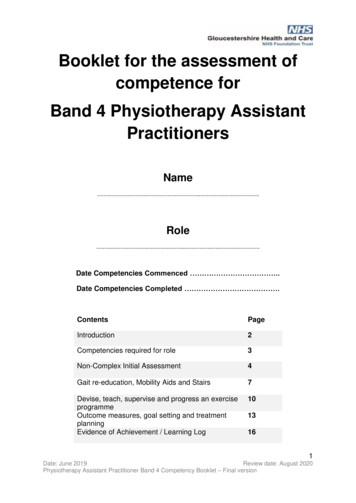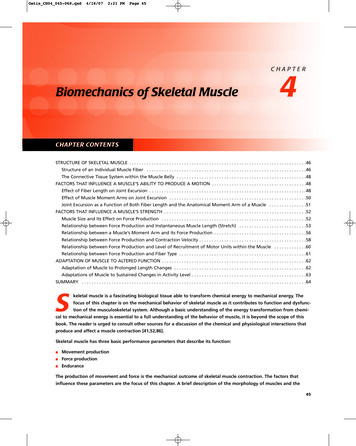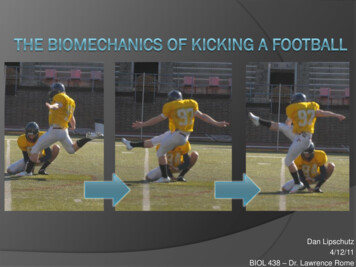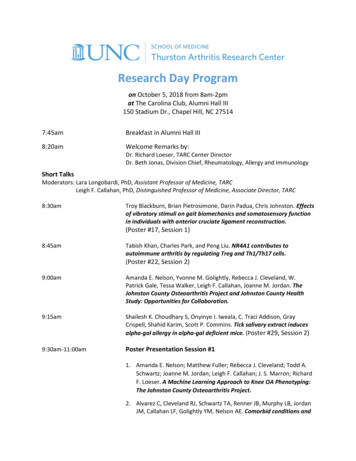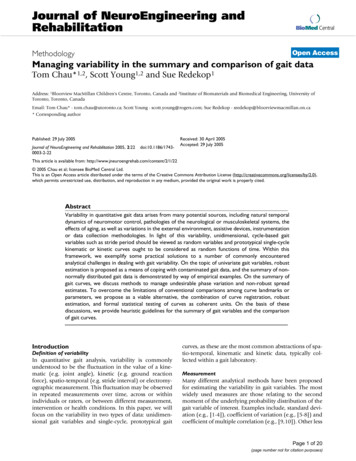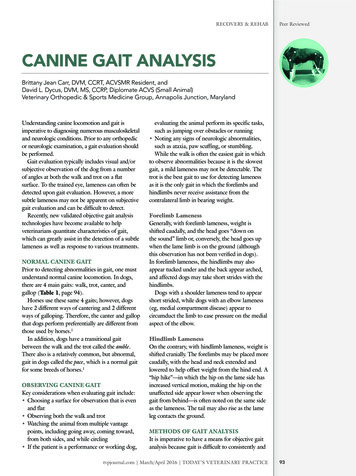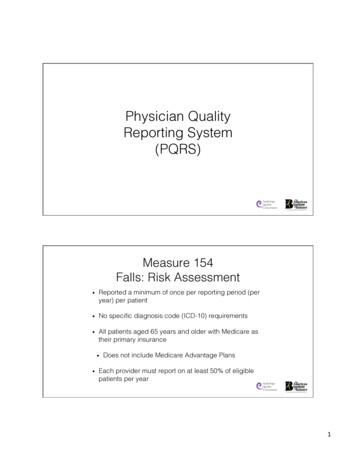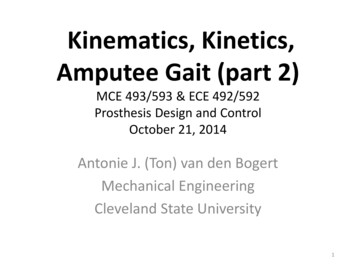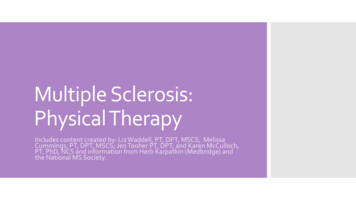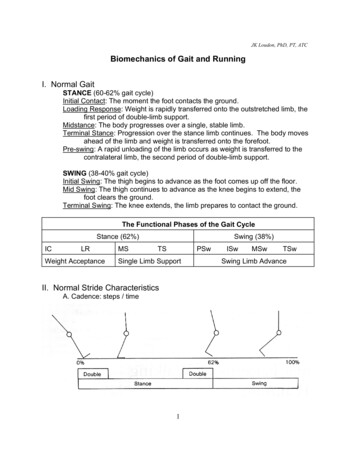
Transcription
JK Loudon, PhD, PT, ATCBiomechanics of Gait and RunningI. Normal GaitSTANCE (60-62% gait cycle)Initial Contact: The moment the foot contacts the ground.Loading Response: Weight is rapidly transferred onto the outstretched limb, thefirst period of double-limb support.Midstance: The body progresses over a single, stable limb.Terminal Stance: Progression over the stance limb continues. The body movesahead of the limb and weight is transferred onto the forefoot.Pre-swing: A rapid unloading of the limb occurs as weight is transferred to thecontralateral limb, the second period of double-limb support.SWING (38-40% gait cycle)Initial Swing: The thigh begins to advance as the foot comes up off the floor.Mid Swing: The thigh continues to advance as the knee begins to extend, thefoot clears the ground.Terminal Swing: The knee extends, the limb prepares to contact the ground.The Functional Phases of the Gait CycleStance (62%)ICLRWeight AcceptanceMSSwing (38%)TSPSwSingle Limb SupportII. Normal Stride CharacteristicsA. Cadence: steps / time1ISwMSwTSwSwing Limb Advance
JK Loudon, PhD, PT, ATCAdult: approx. 2 steps/secFemales (20 - 69 years old): 121 8.5 steps/minMales (20 - 69 years old): 111 7.6 steps/minB. Velocity: distance/timeAdult: 1.4 m/secFemales (20 - 69 years old): 79.3 9.5 m/minMales (20 - 69 years old): 82.1 10.3 m/minC. Stride length: right heel strike to right heel strikeAdult: 1.5 mFemales (20 - 69 years old): 1.32 .13 mMales (20 - 69 years old): 1.48 .15 mIII.JointAbnormalities during Weight Acceptance:Deviation:Possible Cause2
JK Loudon, PhD, PT, ATCTrunkBackward lean: To decrease demand on hip extensors (glut max)Forward lean: Due to increased hip flexion (joint contracture or mm weakness)Lateral Lean: R/L Weak hip abductorsPelvisContralateral drops: Weak hip abductors on reference limbIpsilateral drops: Compensation for shortened limbHipExcessive flexion: Hip flexion contracture, excessive knee flexionLimited flexion: Weakness of hip flexors, decreased hip flexionKneeExcessive flexion: Knee pain, weak quads, short leg on opposite sideHyperextension: Decreased dorsiflexion, weak quadsExtension thrust: Intention to increase limb stabilityAnkleForefoot contact: Heel pain, excessive knee flexion, pf contractureFoot flat contact: Dorsiflexion contracture, weak dorsiflexorsFoot slap: Weak dorsiflexorsToesUp: Compensation for weak anterior tibIV.Abnormalities during Single Limb Support:JointDeviation:Possible CauseTrunkBackward lean: To decrease demand on hip extensors (glut max)Forward lean: Due to increased hip flexion (joint contracture or mm weakness)Lateral Lean: R/L Weak hip abductorsPelvisContralateral drops: Weak hip abductors on reference limbIpsilateral drops: Compensation for shortened limbAnterior Pelvic Tilt: Hip flexion contractureHipLimited flexion: Weakness of hip flexors, decreased hip flexionInternal Rotation: Weak external rotators, femoral anteversionExternal Rotation: Retroversion, limited dorsiflexionAbduction: Reference limb longerAdduction: Secondary to contralateral pelvic dropKneeExcessive flexion: Knee pain, weak quads, short leg on opposite sideHyperextension: Decreased dorsiflexion, weak quadsExtension thrust: Intention to increase limb stabilityWobbles: Impaired proprioceptionVarus: Joint instability, bony deformityValgus: Lateral trunk lean, Joint instability, bony deformityAnkleExcessive plantarflexion: Weak quads, Impaired proprioception, ankle painEarly heel off: Tight dorsiflexors,Increased pronation: STJ deformity,ToesUp: Compensation for weak anterior tib3
JK Loudon, PhD, PT, ATCV.Abnormalities during Swing Limb Advance:JointDeviation:Possible CauseTrunkBackward lean: To decrease demand on hip extensors (glut max)Forward lean: Due to increased hip flexion (joint contracture or mm weakness)Lateral Lean: R/L Weak hip abductorsPelvisHikes: Clear swing limbIpsilateral drops: Weak hip abductors on contralateral sideHipLimited flexion: Weakness of hip flexors, decreased hip flexion, hip painKneeLimited flexion: Excess hip flexion, knee painExcess flexion: Knee contracture, weak quadsAnkleExcessive plantarflexion: Weak quads, Impaired proprioception, ankle painDrag: Secondary to limited hip flexion, knee flexion or excess pfContralateral Vaulting: Compensation for limited flexion of swing or long swinglimbToesInadequate extension:Limited joint motion, forefoot pain, no heel offClawed/hammered: Imbalance of long toe extensors and intrinsics, weak pfVI. Running GaitVariations from walking: STANCE (30 - 40%)Foot Strike:Mid-support:Take-off (propulsion)SWING (60 - 70%)Follow through:Forward swing:Foot descent:4
JK Loudon, PhD, PT, ATCVII.Running Faults:5
JK Loudon, PhD, PT, ATCSubject QuestionnaireNameAgeDateHeightWeightMedical HistoryRelative to the last year, please circle yes or no in each of thefollowing categories as they relate to the hip and/or legs.SurgeriesFracturesMuscle or tendon injuriesLigament injuryCartilage injuryArthritisLow back painHip painKnee painFoot or ankle painLower leg oNoNoNoNoPlease describe in detail any categories checked “yes”Does the problem still bother you?6
JK Loudon, PhD, PT, ATCExercise HistoryAre you currently running/walking?YesNoTypical exercise un surface(concrete.)Do you stretch routinely?If so, list stretches (areas):FootwearType of running shoe:Number of miles on current running shoes:12FSatSun
JK Loudon, PhD, PT, ATCUse shoe inserts/orthotics?EXAMINATION FINDINGSStandingGait:Navicular drop testTibial varumCalcaneal positionSoleus lengthL/S QuadrantRightLeftSingle leg stance (30 sec)Single leg squat (5 reps)ProneRightLeftCalcaneal inversion:Calcaneal eversion:Rearfoot position:FF / RF:First ray position:Great toe extension:Hip joint rotation: IR:ER:Quadriceps lengthDorsiflexion: straight:bent:Callus formation:R:L:SupineHamstring lengthLeg lengthQ-angleSidelyingIT Band:Glut Med strength:Hip flex strengthRightLeftRightLeft13
JK Loudon, PhD, PT, ATCWALKING ASSESSMENTWEIGHT ACCEPTANCE (IC,LR)trunk (lean):pelvis (drop):hip (flexion):knee (position):ankle/foot (contact):toes (up):SINGLE LIMB SUPPORT (MS,TS)trunk (lean):pelvis (drop,tilt):hip (3-plane):knee (3-plane):ankle/foot (heel-off, STJ):toes (up):SWING LIMB ADVANCE (PSW,SW)trunk (lean):pelvis (hike, drop):hip (flexion):knee (flexion):ankle/foot:toes:14
JK Loudon, PhD, PT, ATCWALKING ASSESSMENTWEIGHT ACCEPTANCE (IC,LR)trunk (lean):pelvis (drop):hip (flexion):knee (position):ankle/foot (contact):toes (up):SINGLE LIMB SUPPORT (MS,TS)trunk (lean):pelvis (drop,tilt):hip (3-plane):knee (3-plane):ankle/foot (heel-off, STJ):toes (up):SWING LIMB ADVANCE (PSW,SW)trunk (lean):pelvis (hike, drop):hip (flexion):knee (flexion):ankle/foot:toes:15
JK Loudon, PhD, PT, ATCRUNNING ASSESSMENTFRONTarms cross midlinehead downlands on heelstight shouldersexcessive hip rotationoutward toeingknee alignment(varus/valgus)tibial rotationknee controlSIDEelbow position (90 degrees)tight handshead downforward bendlow kneesincreased foot slapslow leg turnoverover stridingasymmetrical leg swingMTP extensionREARpronation/supinationlateral pelvic tiltpelvic tranverse rotlumbar SBlateral head motionthoracic rotationscapular positioncenter of massfoot crosses midline16
JK Loudon, PhD, PT, ATCRUNNING ASSESSMENTFRONTarms cross midlinehead downlands on heelstight shouldersexcessive hip rotationoutward toeingknee alignment(varus/valgus)tibial rotationknee controlSIDEelbow position (90 degrees)tight handshead downforward bendlow kneesincreased foot slapslow leg turnoverover stridingasymmetrical leg swingMTP extensionREARpronation/supinationlateral pelvic tiltpelvic tranverse rotlumbar SBlateral head motionthoracic rotationscapular positioncenter of massfoot crosses midline17
JK Loudon, PhD, PT, ATCREFERENCESArendt E: Orthopedic issues for active and athletic women. Clin Sports Med 1994; 13(2):483-505.Barber FA, Sutker AN. Iliotibial band syndrome. Sports Med 1992; 14(2):144-148.Beck JL, Wildermuth BP: The Female Athlete’s Knee: Clin Sports Med 1995;4 (2):345366.Brukner P. Exercise-related lower leg pain: an overview. Med Sci Sports Exerc. 32:3,S1-S3, 2000.Donatelli R. The Biomechanics of the Foot and Ankle. Philadelphia:FA Davis, 1996.Fredericson M, Cookingham CL, Chaudhari AM, et al. Hip abductor weakness indistance runners with iliotibial band syndrome. Clin J Sport Med 2000; 10(3):169-175.Gray GW. Rehabilitation of running injuries. Biomechanical and ProprioceptiveConsiderations. Top Acute Care Trauma Rehab. 1(2): 67-78, 1986.Guten GN. Running Injuries. Philadelphia:WB Saunders, 1997.Munro CR, Miller DI, Fuglevand AJ. Ground reaction forces in running: Areexamination. J Biomech 20:147-155, 1987.Norkin C, Levangie P. Joint structure and function: A comprehensive Analysis.Philadelphia:FA Davis, 1992.Orchard JW, Fricker PA, Abud AT, Mason BR.Biomechanics of iliotibial band frictionsyndrome in runners. Am J Sports Med 1996; 24(3):375-379.Panni AS. Overuse injuries of the extensor mechanism in ahtletes. Clin Sports Med2002; 21(3):483-498.Perry J. Anatomy and biomechanics of the hindfoot. Clin Orthop 177:9-15, 1983.Perry J. Gait analysis, normal and pathological function. Thorofare, NJ: Charles B.Slack, 1992.Root ML, Orien WP, Weed JH. Normal and Abnormal Function of the Foot. Los18
JK Loudon, PhD, PT, ATCAngeles: Clinical Biomechanics Corp., 1977.Shangold M, Mirkin G: Women and Exercise-Physiology and Sports Medicine, 2nd ed.Philadelphia, FA Davis, 1994.Sommer HM, Vallentyne SW. Effect of foot posture on the incident of medial tibialstress syndrome. Med Sci Sports Exerc. 27:800-804, 1995.Subotnick SI. Sportsmedicine of the Lower Extremity (2nd ed). Philadelphia:ChurchillLivingstone, 1999.Tiberio D, Gray GW. Kinematics and kinetics during gait. In Donatelli and Wood (eds),Orthopedic Physical Therapy. New York:Churchill Livingstone, 1989.Walsh M. The Running Course. North American Seminars, Chicago, ILL 2000.19
JK Loudon, PhD, PT, ATC 1 Biomechanics of Gait and Running I. Normal Gait STANCE (60-62% gait cycle) Initial Contact: The moment the foot contacts the ground. Loading Response: Weight is rapidly transferred onto the outstretched limb, the
